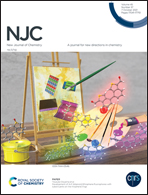Aqueous Na-ion capacitor with CuS graphene composite in symmetric and asymmetric configurations†
Abstract
Sodium ion capacitors (NICs) play a significant role in providing high energy and power densities in a single device at low cost. However, most of the work is focused on exploring the host material to store Na+ ions. This manuscript explores metal chalcogenide for NICs applications. Here, we successfully synthesized a pseudocapacitive copper sulphide (CuS) and its composite with graphene (CuS-G) electrode by a simple chemical route to store Na+ ions. A moderate crystallite size of 25 nm is found for CuS with spherical morphology. Electrochemical studies were performed in an aqueous medium for each of the two and three-electrode systems. The specific capacitances of 87 and 13 F g−1 were obtained at 0.5 A g−1 for the symmetric and asymmetric devices, respectively. For the asymmetric devices, an energy density of 2.6 W h kg−1 (maximum) at a power density of 246 W kg−1 was obtained and reduced to 1 W h kg−1 at the highest power density of 2980 W kg−1. The symmetric device shows a maximum energy density of 30 W h kg−1 at a power density of 380 W kg−1, which is reduced to 4 W h kg−1 at the highest power density of 4224 W kg−1. The cyclic stability for each device was performed up to 1000 cycles. A Coulombic efficiency of 100% is observed for both symmetric and asymmetric devices.



 Please wait while we load your content...
Please wait while we load your content...